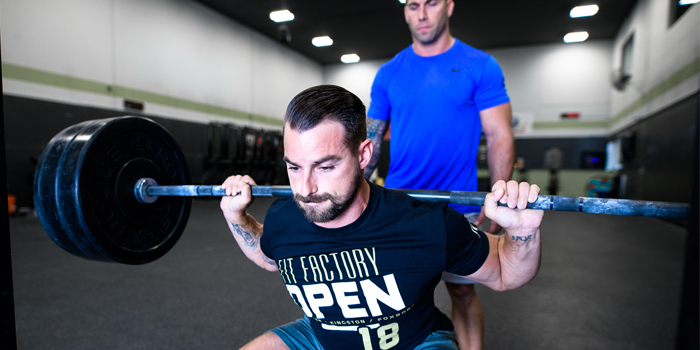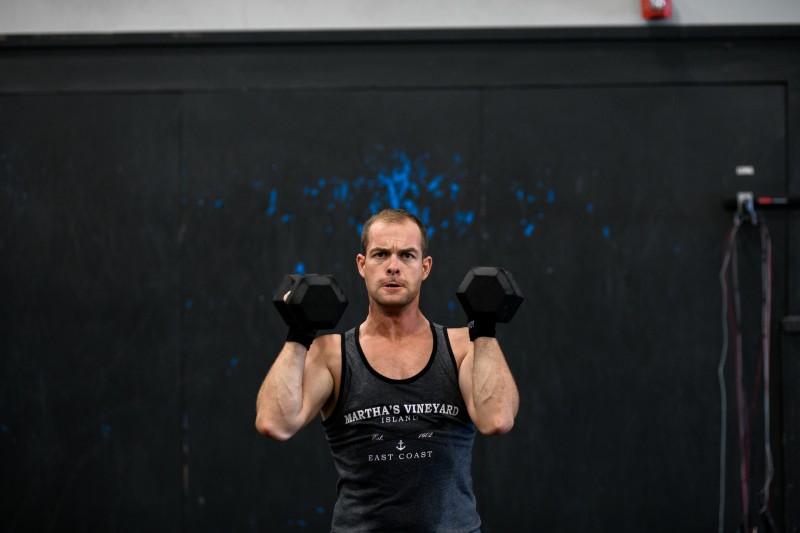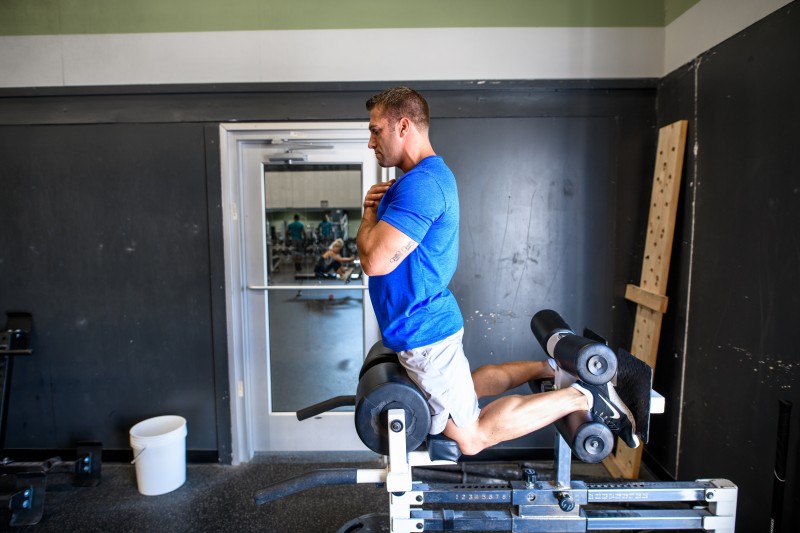
For years, many coaches in box circles have asserted that conditioning should take precedence over strength work. This is clear in the programming of anyone who follows a traditional box model where "strength" days are seldom. And you certainly will never see any single-joint hypertrophy work that aims to improve your performance and what you look like naked.
For the record, I'm not writing this article to bash box programming; I'm writing this to present an alternative way of doing things while STILL utilizing the best aspects of box programming. More importantly, I'm writing this to inform more coaches that you CAN go outside of what's considered the "norm" if it's going to keep your clients healthy and progressing.
Conditioning > Strength?
Let's take a closer look at the month of September. The ENTIRE month had a total of FOUR "strength-only" days. (For the record, August had five strength days, July had four, and June had four, respectively.)
9/4/18
- Snatch 2-2-2-2-2-2
9/11/18
- Split Jerk 1-1-1-1-1-1-1
9/15/18
- Deficit Deadlift 5-5-5-5-5
9/29/18
- 1 Rep of the following complex for max load: Deadlift + Hang Clean + Hang Clean and Jerk
Let's examine this a bit further and discuss WHO is going to incur a strength adaptation if this were his or her only exposure to strength work over the course of a month.
Three of the four days involve complex movement patterns, and you'd need to be very efficient to actually use an appreciable load.
Second, even for those who DO use appreciable loads, Olympic lifting work is quite simply a speed-strength movement that one needs to be proficient with to actually facilitate improvements in the rate of force development (RFD).
This may come as a shock to you, but Olympic lifting is not the best way to make athletes more explosive. A better question should be, in group programming, who really gives a shit about becoming more explosive anyway?
Additionally, you'd need to be using appropriate loading/volume prescriptions if the goal is RFD adaptation (75-85% of 1RM) for all sets/reps (between 15-20 reps). Again, not many of your athletes are actually going to derive actual benefits here other than the lifts are fun to perform!
With that said, I'm not saying don't EVER program the Olympic lifts; just don't build your program around them.
Strength training is connected to other aspects of fitness.
STRENGTH training needs to be a made TOP PRIORITYin group programming, as the carryover to health, performance, and body composition is too great to ignore.
In fact, it's been proven that resistance training is more effective at improving body composition than cardio alone, and there are various studies that go into more depth on this.
I'm not just talking about with a barbell, either. What about single-joint movements that lend themselves to improvements in body composition as well as to getting better at the squat, press, or pull-up?
What about loaded carries that promote aerobic capacity, core control, and grip strength?
All of these things can help folks to reach their goals of looking better and feeling better while still hitting PRs along the way in the classic lifts.
If you're going to tell me that a bicep curl cannot influence someone’s ability to perform a strict pull-up, then stop reading now and save your time.
So, do you still think strength work should take a backseat to conditioning?
Strength Training — What is it?
I'm going to make this article very simple and discuss the plan that we've used with nearly 20,000 athletes worldwide with great success.
I'm also going to explain why things work well this way and the actual meaning behind using many variations in this structured plan.
There is much confusion to what strength training actually is, and I think that's perfectly okay because we are more concerned with the end result.
Although by definition strength is "the ability to exert maximal force," we are going to look at strength from more of a holistic approach encompassing all tools that improve it.
With that said, in our model of strength training, we use bodybuilding (hypertrophy) work to accomplish a few tasks:
- Improve body composition.
- Improve muscular imbalance and posture.
- Improve the strength of smaller muscle groups that assist in complex movements, which then allows our athletes to perform complex movements with less risk of injury.
- Improve neuromuscular efficiency, allowing your athletes to actually use more muscle fibers.
This allows us to consistently access where our clients are lacking and give them the tools to succeed. Additionally, they are able to CLEARLY see why they are weak and take ownership of their limiting factors.
They'll also be less likely to get injured because we've prioritized building their bases of fitness. Not to mention getting a "pump" is pretty damn cool!
Training Template
Now that we know that strength training is going to encompass work other than compound movements of 1-5 reps, we can start to think about how to put this work into context.
Other things that fit into this plan are things like a variety of loaded carries and sled work. This allows us to improve strength qualities and train the aerobic system, but because there is no axial loading, we don't run the risk of piling too much work on our clients. Not to mention this work is critical in building work capacity, so when you program an arduous hero workout on a holiday, your clients will be more capable of handling higher doses of work.
A training template is the easiest way to ensure that we are covering all of our bases as well as looking at biases we may have in our programming.
Some things that we want to make sure happen:
- We train all planes of motion.
- We couple our strength and conditioning work so that the latter does not impair the former.
- Regularly include single-joint special exercises to develop key musculature (in our programming, the upper-back, glutes, triceps, biceps, and hamstrings get a lot of attention).
- Use unconventional methods, such as sleds, loaded carries, or lower-effort aerobic work to bridge the gap between hard training sessions.
Box Programming Training Template
Below, I'm going to lay out our template and explain how things fit together. This will help to show you how to keep things balanced and our athletes progressing. This template is set and does NOT rotate. In group programming, the needs of the many outweigh the needs of the few, so we want to assume that people are going to train at our facility more than twice a week.
Monday
Max Effort Lower-Body
- Rotate between a variety of squats and pulls such as back and front squats variations, box squats, overhead squats, sumo deadlifts, rack deadlifts, power clean or power snatch, squat snatch, squat clean, and good mornings.
- Train MAXIMALLY 1-5 rep maxes. With the more taxing movements, like deadlift variations, maxes tend to be 1-3 rep maxes with full recovery between sets.
- Training MAXIMALLY is a relative term where your beginning to intermediate folks may simply be working on technique or building to a moderate load.
- Conditioning work is higher-threshold and shorter-duration work typically with opposing movement patterns, for example, if we trained a heavy posterior for strength work, the conditioning will likely have more anterior dominance.
- One accessory movement to train the abs or posterior chain. This is done for HIGH volume.
Max Effort Lower-Body Example
Power Clean Clusters:
- Work up to a heavy 1.1 (10s), Rest 2:00
For time:
- 21-15-9
- Front Squat (135, 95)
- Bar Facing Burpees
- *100 Double Unders after each set
Banded Pull-throughs:
4 x 25, Rest 60s
Tuesday
Repetition Upper-body or Dynamic Effort Upper
- Rotate between straight strength-hypertrophy work for the upper body or speed variation.
- Train submaximally for rep work in the 8-15 rep range, multi-joint coupled with single-joint work.
- For Dynamic Effort, work ranges from 75-85% of 1RM for 6-8 sets of 2-3 reps done every 60-90s.
- Dynamic Effort work also acts as a teaching tool for newer athletes.
- Conditioning work is slower today—more aerobic-system, aerobic-power work.
- 1 Accessory movement for the abs, biceps, triceps, or upper back.
Repetition Upper-body or Dynamic Effort Upper Example
1a. DB Bench Press, Neutral Grip
- 4 x 8-10, Rest 30s
1b. 1-Arm KB Rows
- 4 x 8-10 each, Rest 30s
2. EMOM 20:
- MINUTE 1: 200m Run
- MINUTE 2: 15 S20H (135, 95)
- MINUTE 3: 15 Box Jumps w. Step Down (24, 20)
- MINUTE 4: 15 T2B
- MINUTE 5: Rest
3. Banded OH Tricep Extensions
- 4 x 25. Rest 60s
Wednesday
Options
- Long-duration aerobic work
- Skill work
- GPP work
The purpose of today is to either work on the aerobic system, which we can do in a number of ways, or to complete skill-based work that works to reinforce good movement patterns or achieve recovery to manage the effects of stress.
Options Example
Skill work
- EMOM 10:
- ODD Minutes: 30-40s of Gymnastic Skill
- EVEN Minutes: 15 Banded Pull-aparts + 10 Hollow Rocks
Conditioning
5 Rounds of:
- 60-yard Sled Push
- 60-yard Single-Arm Farmer Carry (30y each)
- 60s Recovery on Bike
5 Minutes of Parasympathetic Breathing
Thursday
Dynamic Effort Lower-body
- The purpose of this work is submaximal barbell work that serves to develop movement efficiency and/or to develop a rate of force development.
- Sets range from 8-12 sets x 2-4 reps per set, every 60s with 60-70% of 1RM.
- Variations include all squats and pull variations as well as the Olympic lifts.
- Dynamic Effort work also acts as a teaching tool for newer athletes.
- Conditioning work is higher threshold, shorter duration OR could be slower/aerobic depending on how Friday is structured.
- One accessory movement to train abs or posterior chain
Dynamic Effort Lower-body Example
Wide Stance Box Squat
- 8 x 3 @60%, every 60s
4 Rounds of:
- 12 Deadlifts (225, 155)
- 12 Calorie Assault Bike
- Rest 3:00 after each round
Banded Leg Curl
- 3 x 50 each, No rest
Friday
Max Effort Upper-body
- Heavy compound movement up to a 1-5 rep max with full recovery between sets.
- Variations include a variety of bench press, floor press, overhead press, pull-up/chin-up, and jerks.
- Conditioning threshold dependent on Thursday and could range from shorter/faster to slower/longer.
- One Accessory movement for biceps, triceps, abs, or upper back.
Max Effort Upper-body Example
Medium Grip Floor Press
- Build to a 3RM, Rest 2:00
AMRAP 12:
- 10 Hang Power Snatch (115, 75)
- 10 Pull-ups
- 400 Meter Run
Banded Facepull-aparts
- 4 x 25, Rest 60s
Saturday
Partner Conditioning
- The goal today is to work with another athlete and to have fun!
- This work today will be longer, 25+minutes.
- The output of the workout will vary based on the past 72 hours of work.
- Recovery measures for accessory work
Partner Conditioning Example
For time with a partner:
- 100-80-60-40-20
- Wallballs (20, 14)
- KBS (53, 35)
- Walking Lunges (BW)
- Calories on the Rower
- *2 Rope Climbs after each round
- **One athlete works at a time. Split as needed.
5 minutes of Parasympathetic Breathing
Sunday
For most gyms, this is an "open gym" day, but for those who do run programming, I typically schedule work that's a culmination of the past week while still taking into account the upcoming week.
There are NO benchmark workouts done on Sundays.
Bringing it All Together
If you're looking for a different way of doing things that allows people to get better in all aspects of their fitness but NOT leave anything on the table, this method will get you there. Because of how the weeks are structured, regardless of what your clients schedules are, they will be exposed to work THEY need, whether it's more hypertrophy work or aerobic work.
Overall, randomly programming a 5 x 5 back squat or 7 x 1 jerk is NOT going to get people closer to their goals. There are just too many drawbacks to going that route, like not being able to accurately control or assess volume/intensity distribution, which often results in overtraining. What we can do is make our client's hour at our facility useful by using methods that will benefit EVERYONE and not just the less than 1%. More folks can benefit from some direct arm work than they can a snatch.
The "program for the best, scale for the rest" model negates the needs of those who actually pay your bills. It's time to start putting the majority of your community first. The best part is that even your higher-level athletes will benefit from this approach and still get better; everyone's limiting factors need to be addressed regularly regardless of your goals and level of experience!













What is REALLY cool about Crossfit is the PLANNED, PERIODIZED training that the competitive Crossfitters do, intertwining powerlifting, weightlifting, gymnastics, triathlon and strongman to become literally the most all encompassing athletes humanity has ever seen. Absolutely none of them are just showing up to the gym and doing random stuff everyday.